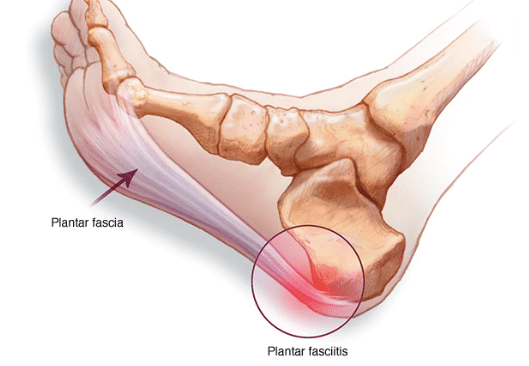Plantar Fasciitis is the most common cause of heel pain and affects approximately 4-7% of the population. It typically affects very physically active people, such as runners, or those who spend a large amount of time standing (often at work). In this blog post, we will look at exactly what is happening, and how physiotherapy can help to resolve your heel pain.
Plantar Fasciitis – What Is It Exactly?
Plantar Fasciitis is an overuse injury of the plantar fascia, which is a band of tissue (fascia) which connects from your heel bone to your toes. Its job is to cushion the foot and absorb shock as you walk and run, and to support the inside arch of your foot. It also has a variety of muscles that attach into it.
Plantar fasciitis is when the plantar fascia becomes inflamed and irritated from overuse. People who develop plantar fasciitis are often runners, or those who spend a lot of time standing at work (particularly those who stand on hard surfaces). A raised BMI is a risk factor for developing plantar fasciitis in those who spend more time standing, due to increased pressure placed on the plantar fascia.
Pain typically comes on gradually, and is felt on the inside of the heel. It often feels worse when you wake up in the morning, and decreases as you move about. However, the pain often returns afterwards, and can progress to feeling pain as you walk. It often isn’t necessary to undergo medical imaging to diagnose plantar fasciitis, although both ultrasound and MRI can help diagnose the condition.
How Do I Treat Plantar Fasciitis?
Treatment of plantar fasciitis will depend on each individual, and often depends if the underlying cause is from lots of standing, or from the repetitive strain of running. However, there are some treatments which crossover between the two underlying causes. Avoiding activities that cause pain, wearing silicone heel pads and ‘sensible’ shoes, and slowly returning to activities that cause pain are all vitally important.
There are a variety of hands-on therapy our physiotherapists provide which can be very efficient in relieving the tension and inflammation around the plantar fascia, including manually stretching it and releasing tight muscles around the area which can contribute to the pain and inflammation that you experience. IMS is also a efficient and effective way at relieving muscular tension around the area and helps many of our patients reach their goals and get back to doing the activities they love to do, but may not be able to because if their limitations and pain. Finally, completing the appropriate stretching and strengthening exercises, which can be prescribed by our physitherapists, helps to remove tension from the foot and helps make the effects of the manual therapy and IMS last longer.
Hopefully you have found this blog post informative. If you are struggling with foot and heel pain, we are here to help! You can check out our online booking page here, or call our clinic directly at 250-493-1152 to learn more about how we can help you!





